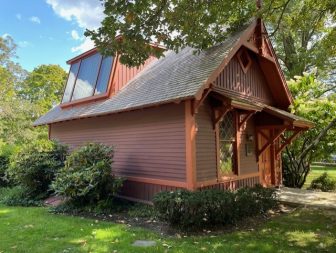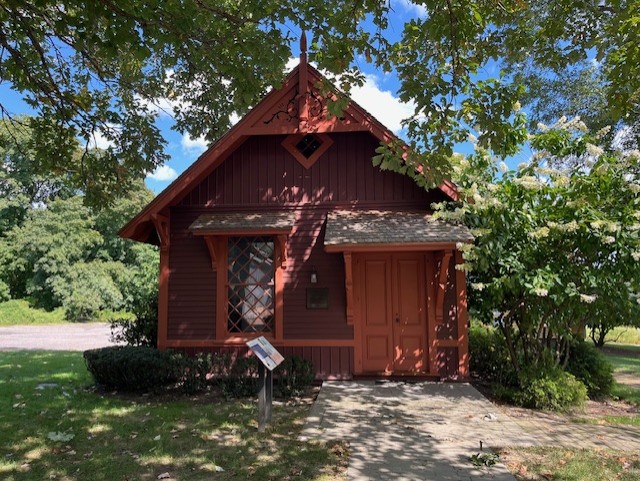The New Canaan Museum & Historical Society this week will reopen the 1878 Rogers Studio after more than two years of work. (It opens Saturday to the public.)
We put some questions to NCM&HS Executive Director Nancy Geary ahead of the Reimagined building’s unveiling.
Here’s our exchange.
***
New Canaanite: Who was John Rogers?
Nancy Geary: Known as the “People’s Sculptor,” John Rogers (1829-1904) was the most popular sculptor in United States history. Between 1860 and 1893, Americans purchased approximately 80,000 of his putty-colored plaster “Rogers Groups” at an average price of $14.00. These realistic works, which celebrated military, theater and domestic scenes, were fixtures in every Victorian parlor. Why? As David Wallace writes in his seminal biography, John Rogers, The People’s Sculptor, (Wesleyan University 1967) “No other American sculptor has ever been so completely at one with his contemporaries in taste, in spirit, and in human sympathies, and none has made his works so generally available to the general public.”
John Rogers was born in Salem, Massachusetts in 1829, the son of John Rogers, a merchant in Boston, and Sarah Ellen Derby, whose grandfather Elias H. “King” Derby, had built a successful shipping empire. By the time of John’s birth, however, the fortune in his mother’s family had dissipated. His father had a series of disastrous forays into business. During John’s childhood, the family moved from Massachusetts to Ohio to New Hampshire, before finally settling in Roxbury, Massachusetts in 1841. In Roxbury, John attended English High School where he studied mathematics, mechanics and surveying. He left school a year early and chose to become an engineer, later holding jobs as a dry goods clerk, a master mechanic and a city surveyor. This practical education and work shaped his artistic vision as a Realist in portraying the American scene.
Rogers discovered his love of art on April 2, 1849. While suffering from a persistent eye infection that threatened to end his career as a civil engineer, he saw a small clay figure. Smitten, he bought some clay, whittled it with modelling sticks, and set up his first figure. He could do the work despite his vision problem and, as he described “found it a great resource and enjoyment.” Ten years later, while a city surveyor in Chicago, he was asked to make a clay group to be raffled off at the Charity Bizarre. His creation – called Checkers Players – was an instantaneous success and resulted in several commissions. His career was born.
Rogers settled in New York City in November 1859 (his apartment was later sold to the Salmagundi Club) and got to work. His success depended upon both an inexpensive, fast production process and a sales force – which included the hiring of an African-American to sell his Slave Auction sculpture to a group of leading abolitionists. He experimented with a variety of medium but, in 1863, decided that bronze and marble were too expensive. With plaster he could produce his cheap statuary and focus on marketing them to the average home.
Rogers rejected neoclassicism and the elitism of its allegorical and philosophical themes of the ideal. Influenced in large part by the Scottish genre painter Sir David Wilkie, Rogers portrayed a variety of occupations and levels of society. He captured humble life and popular subjects in statues such as Checkers or Weighing the Baby – each imbued with his own sense of sentimentality and humor. Comedy – reflected in the stolen chicken bulging from a soldier’s pack, a child’s toe moving a checker piece, or a schoolboy prank – was an important element in his popularity.
Rogers was a fierce abolitionist and defender of President Abraham Lincoln. In 1863, he gave Lincoln Wounded Scout, a statue of a fugitive slave supporting an injured soldier. In a letter of thanks, President Lincoln remarked that it was “very pretty” and added, “I should think an excellent piece of art.” Following Lincoln’s assassination, Rogers produced versions of The Council of War, which Lincoln’s eldest son, Robert Todd Lincoln, pronounced as the best likeness of his father ever created. In 1893, Rogers’ finest monumental work, a statute of Abraham Lincoln, won a medal at the World’s Columbian Exposition in Chicago. (A bronze replica is on display in Manchester, New Hampshire.)
How did his life intersect with New Canaan?
While living in New York City, Rogers brought his family to summer in New Canaan. Later, he purchased a weekend home on Oenoke Ridge (the site of what is now St, Mark’s.) Statues with his children and horses as models reflect the joy of country living and his nostalgia for the carefree days of childhood. In 1897, Rogers and his family moved permanently to New Canaan, where he remained for the rest of his life.
What is happening on Thursday?

The Rogers Studio at the New Canaan Museum & Historical Society. Credit: Michael Dinan
On Thursday, the Studio will reopen after more than two years of work. New Canaan’s state representatives, First Selectmen, Selectmen, family of John Rogers, members of the New Canaan Community Foundation, supporters from the DECD, NCM&HS Board Governors, media, and other guests are invited to the dedication followed by lunch. Lauren Patterson, President and CEO of the NCCF, and Nancy Geary, Executive Director of the NCM&HS, will speak briefly. But mostly it is a chance to thank those who have supported this project and to see the completed exhibition and building.
Tell us a little more about the studio itself. How important is this structure and collection to the NCM&HS?
The 1878 Rogers Studio, a small Victorian building with an enormous skylight, was designed by the renowned Boston architecture firm of Peabody & Stearns. The Rogers Studio was moved onto the campus of the New Canaan Historical Society in 1965 and designated by the Department of the Interior as a National Historic Landmark for its exceptional ability to illustrate United States heritage. This building was the first in New Canaan to receive this designation; the only other Landmark is the Glass house, which was designated thirty years later. The studio houses a substantial exhibition of Rogers’ work, including groups that were donated by the Greenwich Historical Society and on loan from the Hyde Collection. The exhibition was made possible due to the generosity of the New Canaan Community Foundation and a “Good to Great Grant” from the CT State Historic Preservation Office that is part of the Department of Economic and Community Development.
The collection of Rogers Groups is one of the most significant in the Museum’s permanent collection, and is the largest in the world. The Museum also houses letters, documents, photographs, and other materials from the estate of John Rogers, whose grandson was a past President of the Historical Society.
What else, if anything, would you like our readers to know about the Rogers Studio or what’s happening this week?
Following Thursday’s opening, the Rogers Studio will be open to the public during Museum hours, Tuesday – Saturday, 10 am – 4 pm. We urge people to come and see the architecture, the art, and to learn about this exceptional New Canaan resident.

Congratulations Nancy and NCM&HS on this wonderful work of preservation.
The Rogers Studio and John Rogers’ work we are all proud of!
This is a fabulous article about another uber-talented New Canaan resident! Thank you for sharing the history of Rogers’ career path, artistic style, and social beliefs. I am looking forward to touring the studio and viewing his masterful works.